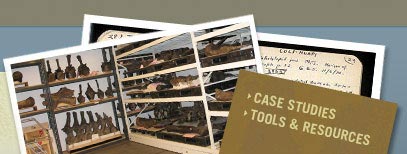Exhibition
Fossil galleries at large and small museums are often among the busiest areas in the entire museum. The display of the fossils excites young and old alike.
Managing exhibition of fossil specimens
To help decide whether it is appropriate to include a particular fossil specimen in an exhibition, the following information should be collected and assessed by a curator, collection manager or conservator:
- The proposed opening date of the show and its duration
- The number and scope of the specimens to be involved, whether type specimens are requested, potential risks to specimens, and the potential impacts on other collection objectives (e.g., research, education, etc.)
- If the exhibit is traveling, the number of venues included
- Who will undertake any preparation, molding, casting, or mounting work required, and how will the specimens be protected during shipping
- Who will undertake condition reports
- Who will be responsible for selecting a shipper
- Any specific transport or security issues or risks
- Whether staff will be expected to travel with the show, or be necessary to facilitate specimen safety
In a world though where children have grown up watching the Jurassic Park movies and seeing animatronic dinosaurs at theme parks, it is amazing to remember that these displays are not casts or computer generated fantasies – but the “real thing”, actual remains of living creatures from the distant past. The power of real objects to inspire and inform, and their importance to the educational mission of a museum, is the main reason that museums put their fossils on display. This outweighs the risk of damage to, or loss of specimens and the limitations placed on their accessibility for research
Exhibitions present particular challenges for managers of paleontology collections. The best specimens for exhibit are often the same ones that are most heavily used for research – i.e., the most complete. These conflicting demands can be particularly problematic if the exhibition is being sent out on tour. The weight and fragility of fossil specimens makes them especially challenging to mount on armatures, and difficult to pack, ship and install if the exhibit travels to multiple venues. Finally, development of displays and exhibitions is time-intensive for staff and can be expensive.
An experienced exhibition designer can minimize some of the damage that can occur to specimens on display from common factors such as light, armature or mounts, touching by visitors and dust and debris. It is advisable to have an Exhibition Policy to help guide decision-making in the exhibition of specimens such as:
- Selection of appropriate specimens
- Assessment of preparation/conservation needs
- Preparation, molding, casting, and/or mounting
- Liaison with registrars and shippers
- Condition reporting
- Installation and deinstallation
For more information…
- The National Park Service’s (NPS) Handbook Chapter 7: Using Museum Collections in Exhibits has a wealth of useful information.
- NPS CD-ROM Exhibit Conservation Guidelines is a compendium of information on how to set up safe and visually attractive exhibits



